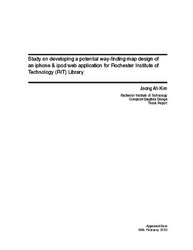| dc.contributor.advisor | Foster, Shaun | |
| dc.contributor.advisor | Smith, Adam | |
| dc.contributor.author | Kim, Jeong | |
| dc.date.accessioned | 2010-03-22T14:27:10Z | |
| dc.date.available | 2010-03-22T14:27:10Z | |
| dc.date.issued | 2010-02-19 | |
| dc.identifier.uri | http://hdl.handle.net/1850/11752 | |
| dc.description.abstract | Have you ever wondered how many wall maps are actually used as "maps" rather than as decoration? Have you ever had trouble finding your way around small areas? Have you ever had a hard time finding brochures, even when they're displayed right at the entry or on the first floor of a building?
Since the beginning of human civilization, wayfinding systems have been developed as tools to deliver information and assist people seeking routes or specific locations. Updates to new technologies have allowed vast quantities of information of varying quality to become a huge part of our lives. However, signs and brochures are limited as far as offering users valuable information for various reasons: limited screen space for content, limited technical abilities of users, and the possibility of a ubiquitous environment.
Given the problems arising from such limitations, developing a wayfinding map application for the iPhone may be the best solution for two reasons. First, the limitation caused by a small display can be improved with the possibility of interactions. Moreover, users would be able to download such an application from the App Store at any time and in any location.
For this project, the Rochester Institute of Technology (RIT) library floor map was chosen as the best experimental item to improve because it contains poor map contents and its design is of low quality. In other words, this floor map presents a number of challenges and has great potential to be redesigned. In particular, creating a novel design of this map is an excellent challenge.
Developing the RIT library floor map application involved research, design methodology, user testing, and technical implements. Ultimately, the project suggests a new wayfinding system using information contents, design improvements, and new technical elements.
In conclusion, I expect to solve problems related to displayed maps and hard-to-obtain contents by creating an improved concurrent wayfinding system as a new Web application for a portable navigation device, the iPhone. In addition, I expect to improve graphic user interface environments. This project, developed for the RIT library navigation system, will be one example of a solution for contemporary wayfinding systems. | en_US |
| dc.language.iso | en_US | en_US |
| dc.relation | RIT Scholars content from RIT Digital Media Library has moved from http://ritdml.rit.edu/handle/1850/11752 to RIT Scholar Works http://scholarworks.rit.edu/theses/6362, please update your feeds & links! | |
| dc.subject | Interaction | en_US |
| dc.subject | iPhone application | en_US |
| dc.subject | Mobile device | en_US |
| dc.subject | Navigation | en_US |
| dc.subject | RIT library | en_US |
| dc.subject | Way-finding | en_US |
| dc.subject.lcc | QA76.76.I59 K57 2010 | |
| dc.subject.lcsh | Rochester Institute of Technology-- Wallace Library--Maps--Interactive multimedia--Design | en_US |
| dc.subject.lcsh | Interactive multimedia--Design | en_US |
| dc.subject.lcsh | iPhone (Smartphone)--Programming | en_US |
| dc.subject.lcsh | iPod (Digital music player)--Programming | en_US |
| dc.subject.lcsh | Visual communication | en_US |
| dc.title | Study on developing a potential way-finding map design of an iphone & ipod web application for Rochester Institute of Technology (RIT) library | en_US |
| dc.type | Thesis | en_US |
| dc.description.college | College of Imaging Arts and Sciences | en_US |
| dc.description.department | Computer Graphics Design | en_US |
| dc.contributor.advisorChair | Jackson, Chris | |

